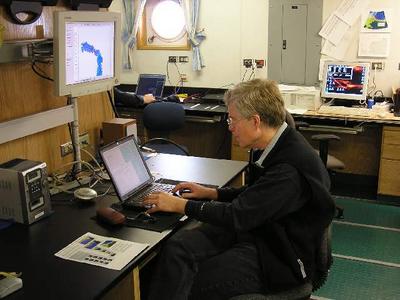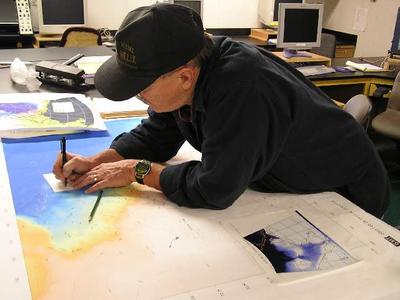25 July, 2003
One of the advantages that these little lap top computers offer is
the ability for scientists to quickly analyze and assess the data
while it is being collected during the cruise. Not long ago,
oceanographers painstakingly plotted each location by hand, labeled
the values that were being measured, and then, rather crudely sketch
the contours that connected the numerous data points to get a handle
on what they were seeing. This was often done weeks - if not months
- later after the cruise was over.
Nowadays, of course, with a few simple clicks on the desired
variables, figures, graphs, and maps can be generated almost
instantly. This is a tremendous benefit, of course, to scientists
since they can use this information readily at hand to modify plans
that will enable them to better attain the program's goals.
It's also exciting to see our efforts bear some fruit while we are
hard at it out at sea. One early finding, for example, are some
unique features in the water columns of several sections (i.e. lines
of stations) that we recently completed across Barrow Canyon. We
have detected layers of relatively low and relatively high-oxygenated
waters from approximately 50-120 meters deep in an underwater canyon
trending in a southeast to northwest direction offshore of Barrow.
According to Chief Scientist, Jim Swift, " . . .these were first
noticed in the CTD oxygen probe data, but their characteristics show
up in nearly all of our measurements." These narrow bands of sea
water, he goes on to say, "seem to be shelf-water outflows pouring
into the upper reaches of Barrow Canyon and subsequently draining
into the Arctic Ocean through Barrow Canyon. Our remaining Chukchi
shelf stations will hopefully show us the source region for these
outflows of water." Jim's guessing that this will be found in a
slight depression in the shelf to the southwest of the canyon.
Another example of quick-access data resulted in the observation of
two distinct eddies in the water along our most recent section of
stations. This may represent an outflow from another underwater
canyon further to the west of our present location. The really cool
thing is this: the computers on board will permit Jim to do a quick
analysis of the data with just a few clicks of the appropriate
buttons to either confirm or reject this idea.
It's time to go as another rosette cast is on its way up with more
CTD data, water samples, and maybe, some answers to our questions.

Jim Swift looking at the numbers.

Dean Stockwell consulting the charts before the next cast.

Graduate student Craig Aumack monitoring the CTD data while conducting a cast of the rosette.
Contact the TEA in the field at
.
If you cannot connect through your browser, copy the
TEA's e-mail address in the "To:" line of
your favorite e-mail package.
|
